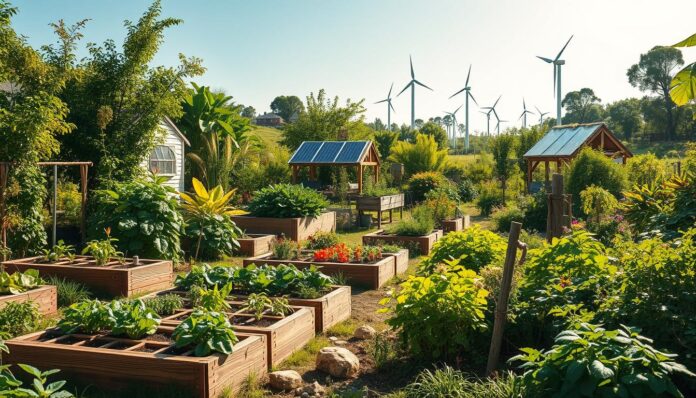Have you ever thought about how technology could change sustainable farming? It’s moving from a small idea to a big solution worldwide. Now, permaculture technology and new farming methods are changing how we grow food and care for the earth.
More than 100,000 students globally have learned about permaculture. This field is growing fast. Permaculture technology is a new way to farm sustainably. It mixes the latest tech with nature’s design.
Farmers can now make their farms better, more productive, and kinder to the environment. They use smart systems and new tech for this. This includes better water use and planning crops with data. Permaculture technology helps solve big food problems worldwide.
Key Takeaways
- Permaculture technology combines innovative solutions with ecological design
- Smart systems can enhance agricultural productivity and sustainability
- Over 100,000 students have been trained in permaculture principles
- Technology enables more efficient resource management
- Sustainable farming practices can address global food security challenges
Understanding Permaculture Technology
Permaculture technology is a new way to live sustainably. It combines old wisdom with new ideas. Exploring permaculture practices shows a complex system that’s more than just farming.
At its heart, permaculture technology blends agroecology with advanced design. It changes how we deal with nature. It makes farming and community building better and greener.
Defining Permaculture Technology
Permaculture technology is a whole design method. It:
- Mimics nature’s patterns
- Uses resources wisely
- Links farms together
Importance in Sustainable Agriculture
“Permaculture is about creating sustainable human settlements that work with nature, not against it.” – Bill Mollison
Permaculture technology is key in sustainable farming. Ecosystem design principles help farmers and communities. They make food systems that:
- Are kind to the environment
- Grow more food
- Save natural resources
| Traditional Agriculture | Permaculture Technology |
|---|---|
| Uses resources in a straight line | Manages resources in a circle |
| Relies on chemicals | Uses nature’s helpers |
| Focuses on one crop | Uses many crops together |
With worries about climate change and food, permaculture is a bright spot. It’s a way to farm that works in many places and meets different needs.
Key Principles of Permaculture
Permaculture is a way to design systems that work well with nature. It uses new ideas to make systems that are efficient and productive. These systems help us use resources better.
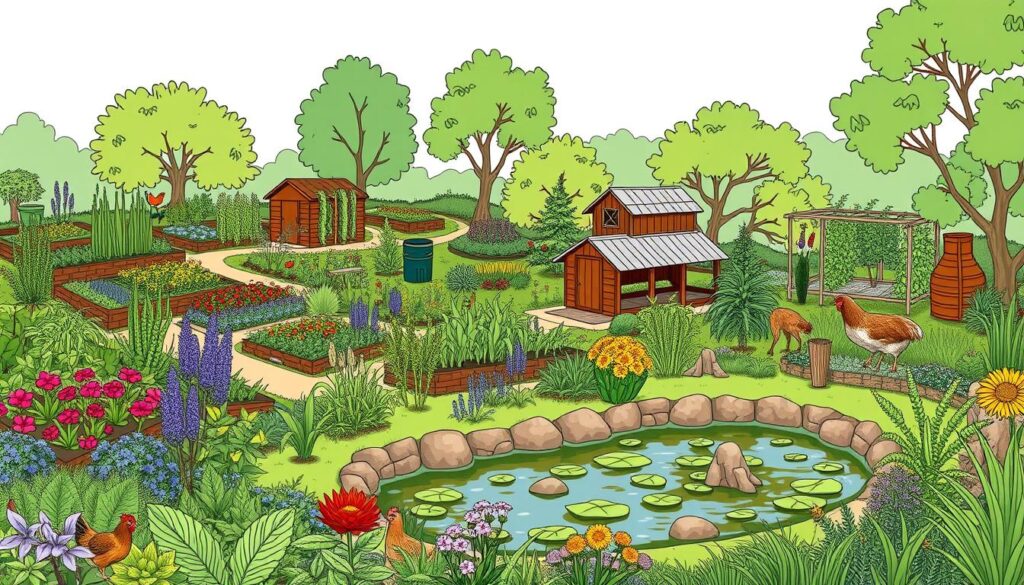
The main ideas of permaculture show us how to live and farm in a sustainable way. They help us make places that are strong, productive, and waste little. This way, we use nature’s power to its fullest.
Observe and Interact
The first key idea is to really know the environment. We do this by watching it closely. Now, we also use new tools like sensors and data to understand nature better. Permaculture experts use these tools to learn a lot about nature.
- Use digital maps
- Put in environmental sensors
- Study how ecosystems work together
Catch and Store Energy
Catching and saving energy is another important idea. This means using renewable energy and keeping it in the system.
| Energy Source | Capture Method | Storage Technique |
|---|---|---|
| Solar | Photovoltaic Panels | Battery Systems |
| Wind | Turbine Generation | Grid Connection |
| Water | Rainwater Harvesting | Underground Cisterns |
Obtain a Yield
The last key idea is about making things productive. By combining different parts, permaculture systems can produce a lot while keeping nature in balance. Using precision farming and smart picking helps us grow more without harming the environment.
“In permaculture, every element serves multiple functions, transforming potential waste into valuable resources.” – Permaculture Design Methodology
These ideas show how technology and knowing nature can make systems that are good for us and the planet.
Types of Permaculture Technologies
Permaculture technologies are new ways to make farming better. They use nature’s ideas to improve how we farm and use resources.
Permaculture design uses many smart farming methods. These technologies help make farming better for the planet.
Water Management Innovations
Good water management is key for farming. Some important methods include:
- Rainwater harvesting systems
- Precision drip irrigation
- Greywater recycling techniques
Soil Fertility Enhancement Technologies
Soil health is vital for good farming. New ways to make soil better include:
- Precision composting methods
- Biochar production techniques
- Microbiome management tools
Renewable Energy Solutions
| Technology | Application | Efficiency |
|---|---|---|
| Solar Panels | Farm Power Generation | 85% |
| Wind Turbines | Irrigation Support | 75% |
| Biogas Systems | Waste Conversion | 65% |
“Permaculture technologies mimic nature’s elegant solutions, transforming agricultural practices into sustainable ecosystems.”
Using these advanced methods, farmers can make their farms better. They can work with nature to grow more food.
Advantages of Using Permaculture Technology
Permaculture technology changes how we grow food and care for our environment. It helps farmers and gardeners make systems that are strong and help both people and nature.
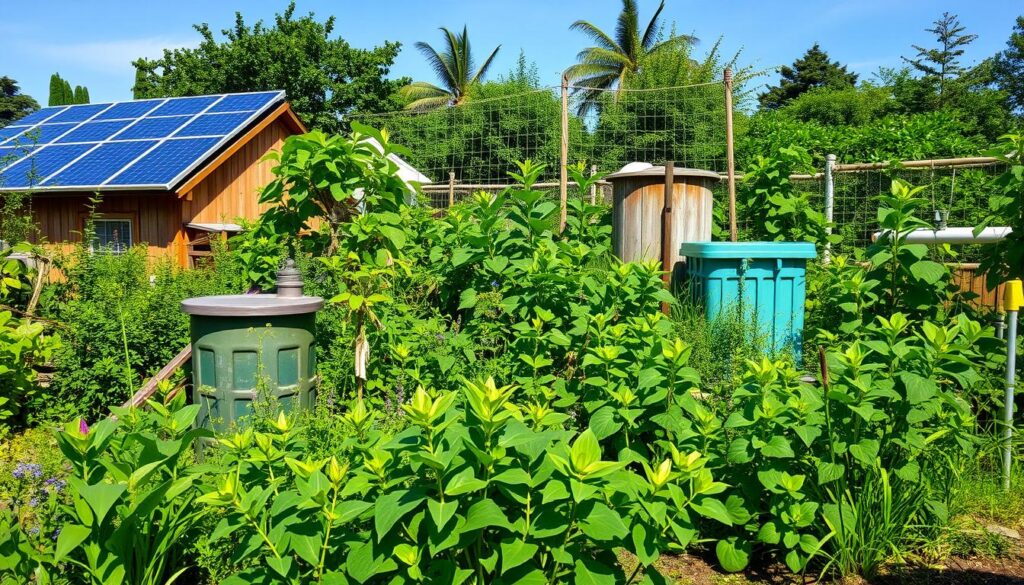
Permaculture technology has many benefits for farming. It’s great for food forests and making farming better for the planet.
Enhancing Biodiversity
Permaculture helps keep ecosystems diverse. Studies show it can boost biodiversity by up to 30% compared to old farming ways. Key steps include:
- Integrating native perennial plants
- Creating habitat corridors
- Promoting complex plant interactions
- Supporting local insect populations
“Biodiversity is not just about numbers, but about creating interconnected, resilient ecosystems.” – Permaculture Design Principle
Reducing Waste
Permaculture makes farming waste-free. It can cut plastic waste by up to 90%. Ways to do this include:
- Natural composting methods
- Integrated pest management
- Circular resource utilization
- Efficient nutrient cycling
Improving Soil Health
Permaculture makes soil better. It can improve soil health by 40% in 3-5 years. This reduces erosion by 50%. Important steps are:
- Minimal soil disturbance
- Continuous ground cover
- Organic mulching techniques
- Precision nutrient application
Using these advanced methods, farmers and gardeners can make farming better for the planet and more productive.
Implementing Permaculture Design
Permaculture technology changes how we manage land and design ecosystems. It uses advanced methods to create sustainable systems. Site assessment is key in starting effective permaculture plans.
Site Assessment Techniques
Good site assessment needs a deep understanding of the landscape. Designers use ecosystem principles to check important environmental factors:
- Topographical mapping using drone technology
- Soil composition analysis with advanced sensors
- Microclimate evaluation
- Water resource identification
Creating a Permaculture Design Plan
Making a permaculture design plan involves several important steps. It uses technology to make the most of land and resources.
| Design Element | Technology Used | Expected Outcome |
|---|---|---|
| Water Management | GIS Mapping | 70% Water Conservation |
| Crop Placement | Climate Modeling Software | 30-150% Yield Increase |
| Energy Systems | Renewable Integration Tools | 40-60% Energy Cost Reduction |
“Permaculture design is about creating resilient systems that work with nature, not against it.” – Permaculture Design Expert
Using permaculture technology, designers can create solutions that improve ecosystem health and meet human needs. Advanced tools help in managing land more precisely and effectively.
Tools and Equipment for Permaculture
Permaculture needs the right tools to support sustainable farming and manage natural resources well. The right equipment helps gardeners and farmers work better with their environment. This leads to more productive and green systems.
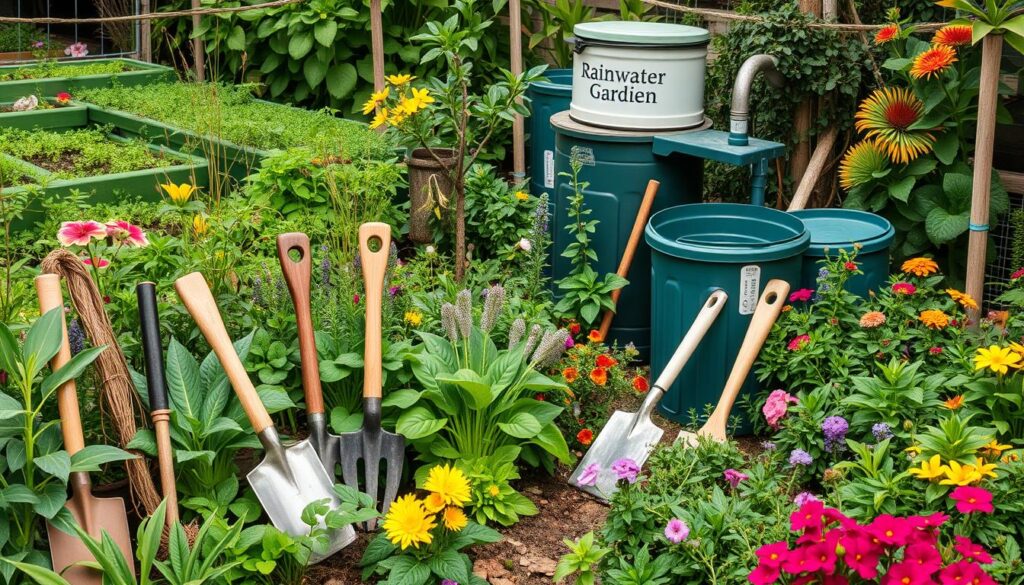
Essential Manual Tools for Permaculture
The permaculture toolkit focuses on quality over quantity. It suggests a few key tools that are versatile and support ecological farming:
- Spade and garden fork for soil preparation
- Pruning saw and loppers for managing plants
- Wheelbarrow for moving materials
- Secateurs for detailed plant care
- Scythe for cutting grass and plants
“Choose tools that work with nature, not against it.” – Permaculture Design Principle
Innovative Technology Solutions
Modern permaculture uses smart tech to better manage natural resources. Tools like precision seeders and AI for crop monitoring help farmers improve their farming.
| Technology | Purpose |
|---|---|
| Jang Seeder | Precision direct seeding |
| BCS Two-Wheeled Tractor | Small-scale land preparation |
| DeWalt Flexvolt Drill | Versatile power tool system |
Water Harvesting Systems
Managing water is key in sustainable farming. Permaculture offers many ways to save and use water, from simple swales to advanced rainwater systems.
- Gravity-fed irrigation systems
- Rainwater catchment structures
- Computerized water monitoring tools
Case Studies: Successful Permaculture Projects
Permaculture projects in the United States show the power of regenerative agriculture and food forests. They use technology and design to change how we farm and grow food. This approach is making a big difference in our communities.
Urban Permaculture in Los Angeles
Los Angeles is leading the way in urban farming. Small spaces are being turned into food forests. This is done with vertical gardens and smart design.
- Implemented raised bed systems
- Integrated water-efficient irrigation technologies
- Created multi-layered food forest ecosystems
Community Gardens in New York City
New York City’s community gardens are a great example of working together. People use digital tools to share and work on gardens in different areas.
“Our community garden is more than food production—it’s about reconnecting with nature in the heart of the city.” – Local NYC Gardener
Regenerative Farms in Oregon
Oregon’s farms show how big permaculture can be. They use new tech to make soil better and increase diversity.
| Farm Metric | Year One | Year Five |
|---|---|---|
| Total Land Area | 1 acre | 3 acres |
| Total Revenue | $2,000 | $72,000 |
| Net Profit | $0 | $32,000 |
These examples show how permaculture can change farming for the better. It makes farming sustainable and helps both local areas and the environment.
Challenges in Permaculture Technology Integration
Bringing sustainable farming into our agricultural systems is tough. It needs new ideas to solve old problems. Farmers and experts face big hurdles when trying to use agroecology systems.
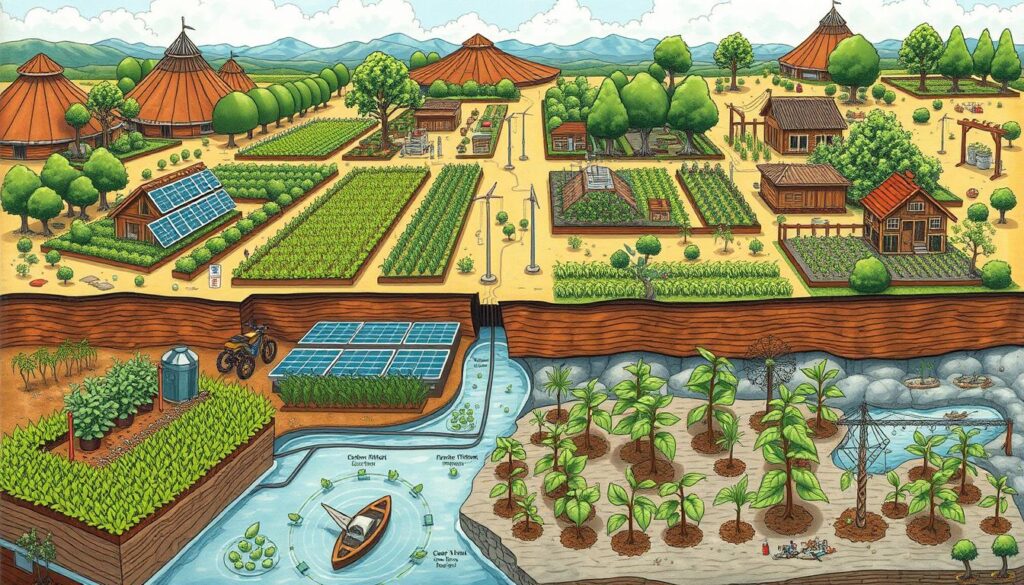
Changing how we farm is a big task. It means tackling major obstacles to using new tech and ideas.
Financial Barriers in Sustainable Agriculture
Starting with new farming tech costs a lot of money. Farmers have to deal with many money problems when moving to sustainable permaculture practices.
- High initial equipment costs
- Limited access to funding
- Risk of reduced short-term productivity
- Lack of financial incentives
Knowledge and Skill Gaps
Many farmers are hesitant to change because they don’t know about new tech. They face challenges because they lack the knowledge needed for sustainable farming.
| Challenge | Impact | Potential Solution |
|---|---|---|
| Technical Understanding | Low Technology Adoption | Training Programs |
| Skill Development | Inefficient Implementation | Workshops |
| Cultural Resistance | Slow Transformation | Community Engagement |
“The greatest obstacle to implementing sustainable agriculture is not technology, but mindset.”
We need to work together to help farmers. Schools, governments, and farming groups must support them. This way, we can move towards more sustainable and resilient farming systems.
The Role of Permaculture in Climate Resilience
Permaculture is a powerful way to fight climate change. It uses new ways to design ecosystems. This helps communities build strong plans for fixing the environment and staying resilient.
Climate challenges need creative answers. Permaculture gives a full plan to handle environmental dangers. It does this by managing ecosystems wisely.
Mitigating Climate Change Effects
Regenerative agriculture is key in fighting climate change. It uses new methods to tackle the problem:
- Carbon sequestration through advanced soil management
- Water conservation using smart irrigation systems
- Biodiversity preservation via habitat monitoring technologies
“Permaculture is not just about growing food, but about creating resilient systems that can adapt to changing environmental conditions.”
Promoting Ecosystem Restoration
Ecosystem design principles lead to big changes in fixing landscapes. By using smart strategies, permaculture experts can fix damaged areas. They also make ecosystems more productive.
| Permaculture Strategy | Climate Resilience Impact |
|---|---|
| Agroforestry | Increases carbon sequestration by 200% |
| Polyculture Farming | Reduces pest vulnerability by 60% |
| Water Harvesting | Improves drought resistance |
Using regenerative agriculture shows great promise. It helps build sustainable, climate-resilient food systems. These systems work with nature, not against it.
Future of Permaculture Technology
The world of sustainable farming is changing fast. New permaculture technology is coming in. It aims to change how we farm and take care of our ecosystems.
Emerging Innovations in Agriculture
New tech is making permaculture better. Sustainable farming now uses smart tools. These tools help manage ecosystems and make farming more productive.
- AI-powered ecosystem monitoring systems
- Blockchain for transparent agricultural supply chains
- Advanced biotechnology for soil regeneration
- Precision agricultural robotics
Scaling Permaculture Through Technology
Permaculture technology can grow a lot. Here are some interesting facts:
| Technology Metric | Projected Growth |
|---|---|
| Precision Agriculture Market | USD 12 billion by 2025 |
| Agricultural Robotics Market | USD 75 billion by 2032 |
| Farmers Using Digital Technologies | 60% as of 2023 |
“Technology is not just a tool, but a bridge connecting sustainable practices with global agricultural transformation.”
New tech can solve big problems like food security and environmental issues. It helps farmers make their farms better for the planet and more productive.
Education and Resources
Permaculture education is key for solving big problems in farming and nature care. People from many fields want to learn about agroecology systems. They aim to tackle tough environmental issues.
There are many ways to learn about permaculture. These resources mix old wisdom with new tech. They help people understand how to design better ecosystems.
Online Courses and Webinars
Online learning has changed how we get permaculture education. It offers many ways to learn:
- Comprehensive online certification programs
- Interactive webinars with global experts
- Self-paced courses in ecological design
- Virtual workshops focusing on practical implementation
Books and Publications
“Knowledge is the foundation of transformative ecological design” – Ecological Design Pioneers
Important books in permaculture share valuable insights. They help us understand sustainable practices:
- Comprehensive guides on agroecology systems
- Technical manuals for ecosystem restoration
- Research-based texts exploring innovative design strategies
- Practical handbooks for sustainable technology integration
Those looking to grow in permaculture can use these resources. They help create smart ecological solutions. These solutions work with nature and human needs.
Community Engagement in Permaculture
Permaculture is all about working together to make our surroundings better. It turns local areas into green, sustainable places. This way, we can help both our community and the environment.
At the core of permaculture is community involvement. A study with eight people showed how important it is. It included four garden leaders and four permaculture teachers.
Collaboration Projects
Good permaculture projects use everyone’s skills and resources. Here are some key ways to work together:
- Building shared food forests in cities
- Setting up systems that grow more food locally
- Starting community nurseries for saving seeds
- Using simple, green solutions like solar ovens and biodigesters
Local Workshops and Events
Learning events are key to sharing permaculture ideas. Workshops offer hands-on training in:
- How to grow food in a way that’s good for the planet
- Designing sustainable spaces
- Creating energy-saving community projects
- Keeping biodiversity alive
“Community input is essential in developing resilient food systems that address environmental, social, and economic challenges.”
The study showed how permaculture can change lives in poor areas. It showed that working together can lead to big changes and empower communities.
Government Policies Supporting Permaculture
Government actions have changed the face of sustainable farming. They now see the importance of managing natural resources. This is key to building strong agricultural systems.
Since 1978, government support for permaculture has grown a lot. Now, it combines economic growth with protecting the environment.
State and Federal Program Highlights
- USDA sustainable agriculture grants
- Environmental Protection Agency conservation initiatives
- State-level ecological farming programs
Funding Opportunities for Permaculture Projects
| Program Name | Funding Range | Focus Area |
|---|---|---|
| Sustainable Agriculture Research Grant | $25,000 – $250,000 | Innovation in Farming Practices |
| Community Resilience Initiative | $50,000 – $500,000 | Local Food Systems |
| Environmental Stewardship Program | $10,000 – $100,000 | Ecosystem Restoration |
Public policies are now focused on promoting sustainable farming. Grassroots movements have played a crucial role in shaping these policy directions. They show the strength of community-led environmental efforts.
“Government support can accelerate the adoption of permaculture technology by providing strategic financial and educational resources.” – Sustainable Agriculture Policy Institute
The link between government policies and permaculture is very promising. It opens up new funding and support options for farmers. This is a big step toward more sustainable and resilient farming.
Networking and Permaculture Communities
Connecting with others who share your interests is key in permaculture. It helps spread knowledge and drive innovation. Permaculture folks know that community is powerful.
Local Permaculture Groups: Building Grassroots Connections
Local groups are essential for sharing and learning together. They let people:
- Share tips on ecosystem design
- Join hands-on workshops
- Work on community projects
- Support local farming
Online Platforms and Digital Communities
Online spaces have changed how we network in permaculture. They let us share knowledge worldwide. Forums and social media groups connect us all.
| Platform Type | Key Benefits | Community Impact |
|---|---|---|
| Facebook Groups | Instant communication | Global knowledge exchange |
| Reddit Forums | Specialized discussions | Technical problem-solving |
| Dedicated Permaculture Websites | Comprehensive resources | Structured learning opportunities |
“Community is the cornerstone of sustainable transformation in permaculture technology.” – Permaculture Action Network
The Permaculture Action Network shows how to engage communities. In 2014, they launched a tour in 32 cities, working with musicians and activists to promote sustainability. Their work shows how networking can make a big difference in many places.
Global Perspectives on Permaculture Technology
Permaculture is changing the way we farm, with over 2,500 projects worldwide. These projects are in schools, businesses, and communities. They show how regenerative agriculture works in different places.
In Austria, farmer Sepp Holzer’s courses drew people from all walks of life. This shows how appealing sustainable farming is. The United Nations sees permaculture as key to stopping land damage, showing its importance worldwide.
Indigenous knowledge is vital in permaculture. It brings ancient wisdom to modern farming. The European Commission sees permaculture as a model for green farming, tackling big environmental issues.
Studies back up permaculture’s success. They show more biodiversity, better soil, and yields as good as industrial farming. As the world faces more environmental problems, permaculture is a hopeful solution. It balances food needs with respect for nature and culture.

